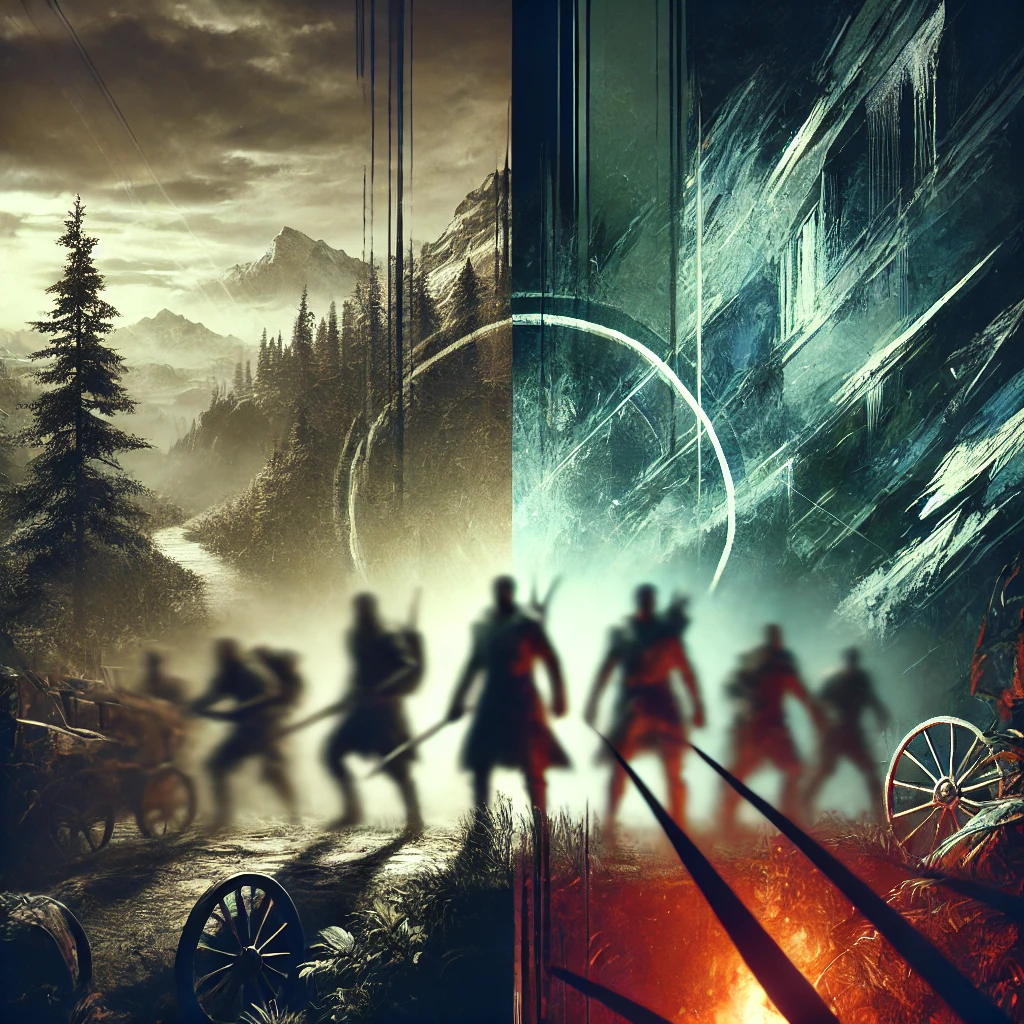Introduction to Golden Kamuy

Have you ever wondered what happens when history, adventure, and survival combine into one gripping story? Golden Kamuy does just that. This anime is a fascinating blend of historical events and thrilling action, set in early 20th-century Japan, just after the Russo-Japanese War. The main character, Saichi Sugimoto, a war veteran known as “Sugimoto the Immortal,” teams up with a young Ainu girl named Asirpa to search for a hidden treasure of gold. Their journey, however, is far from simple. With dangerous enemies and wild terrain to contend with, Golden Kamuy offers a heart-pounding adventure.
But Golden Kamuy isn’t just an ordinary adventure anime. What truly sets it apart is its rich exploration of Ainu culture, a group indigenous to northern Japan. The show does an impressive job weaving Ainu traditions, language, and survival techniques into the plot. This creates an educational experience for viewers, offering insights into a lesser-known part of Japanese history. The attention to detail when it comes to Ainu life, from their unique way of hunting to their spiritual beliefs, adds layers of authenticity and intrigue to the story.
The series also shines in how it balances different genres. Yes, it’s a historical anime, but it’s also a survival story, with characters constantly facing life-or-death challenges. Plus, there’s a good dose of humor and character development that keeps it feeling fresh and dynamic. This multi-genre approach has helped Golden Kamuy gain popularity not only in Japan but also overseas.
Since its release, Golden Kamuy has attracted a wide audience and continues to leave a mark with its gripping story and deep cultural elements. Whether you're in it for the adventure, the history, or the characters, it’s a series that offers something for everyone.
Plot Overview of Golden Kamuy

Imagine being thrust into the rugged wilderness of Hokkaido with one mission: find a hidden stash of Ainu gold that could change your life forever. That’s exactly where Golden Kamuy takes us, following Saichi Sugimoto, a war veteran from the Russo-Japanese War, who’s determined to locate this treasure. His motivation? To secure a future for his fallen comrade's widow. But this is no simple treasure hunt. The gold’s location is a secret, scattered across tattoos on the bodies of escaped convicts. The only way to piece the map together is to find these convicts—alive or dead.
Sugimoto’s journey takes a sharp turn when he meets Asirpa, a young Ainu girl with her own reasons for joining the quest. Asirpa isn’t just a sidekick; her knowledge of survival in the harsh wilderness and her deep understanding of Ainu culture are vital to Sugimoto’s success. Together, they form an unlikely partnership, bound by their shared goal and mutual respect. Their dynamic is at the heart of the story, providing not only adventure but also moments of genuine warmth and humor.
But of course, it’s not smooth sailing. Golden Kamuy keeps viewers on the edge of their seats with constant threats lurking around every corner. Sugimoto and Asirpa find themselves caught in a web of dangerous alliances, as rival groups also seek the gold. These groups range from rogue military men to the cunning Shiraishi, a convict with his own agenda. Betrayals and shifting loyalties are a constant theme, with the stakes growing higher as the story unfolds.
The beauty of Golden Kamuy is how it balances action with deeper themes. Amidst the thrilling chases and deadly confrontations, there’s a focus on survival—not just in the physical sense, but also cultural survival, especially for Asirpa and the Ainu people. Every step closer to the treasure reveals more about the characters, their motivations, and the darker sides of human nature. Whether it’s a bloody battle or a quiet moment in the wilderness, Golden Kamuy hooks you with its gripping plot and rich storytelling.
Character Profiles of Golden Kamuy

Let’s talk about the characters that drive Golden Kamuy and make it such a compelling story. At the center of it all is Saichi Sugimoto, often referred to as “Sugimoto the Immortal.” Why the nickname? Well, Sugimoto is a former soldier who fought in the Russo-Japanese War, and his reputation for surviving even the deadliest situations has earned him that title. But beneath his hardened exterior, he’s driven by a very personal mission: to find the hidden Ainu gold and support the widow of his fallen comrade. Sugimoto’s loyalty and determination make him a compelling protagonist, always pushing forward no matter the odds. His toughness is matched by his sharp instincts, making him both a formidable fighter and a strategic thinker. And yet, there’s a softer side to him, especially in his interactions with Asirpa.
Asirpa is no ordinary companion. A young Ainu girl, she brings her deep knowledge of the land and survival skills to the table, making her an invaluable partner for Sugimoto. Asirpa’s backstory is rooted in the loss of her father, which ties her personal journey to the very treasure they’re hunting. Her calm wisdom, fierce independence, and unique perspective on the world around her give the series its cultural depth. She teaches Sugimoto about the Ainu way of life, from hunting to their spiritual beliefs, and this dynamic becomes the heart of the story. It’s more than just a quest for gold; it’s a journey of cultural discovery and friendship. And while Asirpa is young, she’s no damsel in distress—her courage often rivals that of Sugimoto’s, and she’s not afraid to stand up for what she believes in.
Then, there’s the ever-enigmatic Shiraishi, known as the “Escape King.” Shiraishi is a convict who frequently finds himself in and out of dangerous situations but always seems to slip away, living up to his reputation. Though he can be a bit of a comic relief character, Shiraishi’s resourcefulness is crucial to their quest, and his unpredictable nature adds a layer of suspense to the group’s dynamic. You never quite know whose side he’s really on, and that keeps viewers on their toes.
Another key figure is Lieutenant Tsurumi, one of the most complex antagonists in Golden Kamuy. His motivations are driven by an intense desire for power, and he’ll stop at nothing to claim the gold for himself. With his disturbingly calm demeanor and strategic brilliance, Tsurumi poses a constant threat to Sugimoto and Asirpa’s mission. His presence is a reminder that not all enemies are obvious—they may be hiding in plain sight, manipulating events from the shadows.
In Golden Kamuy, it’s the rich personalities of these characters that elevate the story beyond a simple treasure hunt. Every character is layered with their own motivations, backstories, and complexities, making them feel real and relatable. Whether it’s Sugimoto’s drive to protect those he cares about, Asirpa’s quest for answers, or Shiraishi’s knack for survival, each brings something unique to the table that shapes the journey in unexpected ways.
Themes and Cultural Significance in Golden Kamuy

One of the things that really sets Golden Kamuy apart from other anime is its rich cultural and historical backdrop. The story takes place in early 20th-century Japan, just after the Russo-Japanese War, a period often overlooked in modern media. This historical setting alone adds a layer of realism to the narrative, as it explores the post-war struggles of soldiers like Saichi Sugimoto, who are left to fend for themselves in a world that’s rapidly changing. But what makes Golden Kamuy truly unique is how it intertwines these historical elements with the rich culture of the Ainu, an indigenous people of northern Japan.
Ainu culture plays a pivotal role throughout the series. From Asirpa’s hunting techniques to the spiritual beliefs that guide her, the show offers a rare and respectful portrayal of this indigenous group. It doesn’t just use Ainu culture as a backdrop—it’s a fundamental part of the plot. For example, Asirpa’s knowledge of the natural world, including how to survive in the harsh wilderness of Hokkaido, gives her and Sugimoto a fighting chance in their dangerous quest. Every episode offers a deeper dive into the Ainu way of life, from their traditional food preparation to their rituals and language, which is seldom seen in mainstream Japanese media.
Survival in the northern wilderness is another major theme that shapes the narrative. The characters are constantly battling the elements, whether it’s freezing temperatures, wild animals, or simply the need to find food and shelter. The series doesn’t sugarcoat how brutal life can be in such a harsh environment, and this struggle for survival mirrors the larger battle for the hidden Ainu gold. The unforgiving landscape almost feels like a character in itself, shaping the fates of those who dare to challenge it. This theme of survival also ties into the cultural aspects, as many of the skills that Asirpa uses to keep the group alive are rooted in Ainu traditions.
Another layer of depth comes from the post-Russo-Japanese War context. Sugimoto is a man haunted by his experiences on the battlefield, and this adds a psychological element to his character. Many of the other characters they encounter are also veterans or people affected by the war, and their motivations often stem from this shared history. This aspect of Golden Kamuy not only adds realism but also invites the audience to think about the lasting impact of war on individuals and societies.
The fusion of historical events, cultural exploration, and survival against the odds creates a story that’s far more than just an adventure. It’s a series that delves into the complexities of identity, both personal and cultural. By highlighting Ainu culture and setting the story in a unique historical context, Golden Kamuy invites viewers to reflect on the often-overlooked parts of Japan’s past, while keeping them hooked with thrilling action and character development.
So, while Golden Kamuy may draw you in with its treasure-hunting premise, it’s the depth of its themes that keeps you invested. From the cultural significance of the Ainu people to the harsh realities of surviving in the wilderness, this anime offers a blend of education and entertainment that’s hard to find elsewhere.
Reception and Impact of Golden Kamuy

When it comes to Golden Kamuy, the global reception has been nothing short of impressive. In Japan, the series quickly gained attention, thanks to its unique blend of historical accuracy, cultural depth, and thrilling adventure. It was well-received by both critics and fans alike, praised for its detailed portrayal of Ainu culture, something rarely explored in mainstream media. The manga, written by Satoru Noda, has been a consistent hit, selling millions of copies and earning a dedicated fanbase. But it didn’t stop there. The anime adaptation took the excitement to another level, attracting even more viewers, both domestically and internationally.
Overseas, Golden Kamuy made a significant impact, especially in the West, where anime fans were drawn to its fresh take on historical storytelling. Viewers outside of Japan were fascinated by the unfamiliar setting of post-Russo-Japanese War Hokkaido and the inclusion of Ainu culture. The series’ mix of action, humor, and deep cultural themes resonated with audiences, leading to a growing fanbase across multiple countries. It quickly became a popular title on streaming platforms, further expanding its reach beyond Japan. Fans appreciated how the show balanced exciting action sequences with educational elements, making it not only entertaining but also enlightening.
The critical acclaim didn’t go unnoticed. Golden Kamuy has received multiple awards and nominations. Most notably, the manga won the 9th Manga Taisho Award in 2016 and was also nominated for the prestigious Tezuka Osamu Cultural Prize. These accolades are a testament to the quality of storytelling and the series' unique place in both the manga and anime industries. The anime adaptation has also been recognized for its voice acting, animation quality, and faithful adaptation of the source material. The series’ use of historical events and its respect for cultural representation have been particularly praised by critics and cultural historians.
Beyond awards, Golden Kamuy has also had a broader influence on anime culture. Its success opened the door for more series to explore lesser-known periods of history and minority cultures. By introducing Ainu culture to a global audience, it sparked discussions and increased awareness about indigenous peoples in Japan, contributing to a greater understanding of cultural diversity. The show’s impact extends to fan communities, with active discussions, fan art, and cosplay thriving online, proving that Golden Kamuy has left a lasting mark on both anime fans and creators.
In summary, Golden Kamuy has not only been a hit in Japan but has also captured the hearts of international audiences. Its combination of adventure, history, and cultural exploration has earned it critical acclaim, a strong fanbase, and an enduring influence on anime culture. Whether through its gripping story, its cultural significance, or its engaging characters, Golden Kamuy continues to be a standout in the world of anime and manga.